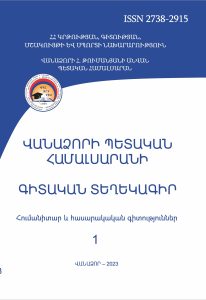The Myth of “Unity” as a Reality Construction Tool
Scientific Proceedings of Vanadzor State University Humanitarian and Social Sciences (ISSN 2738-2915)
2023 vol 1
The Myth of “Unity” as a Reality Construction Tool
Liana Martirosyan
Summary
 Key words. political myths, contrasts, majority, spiral of silence, struggle, political program, myth-making
Key words. political myths, contrasts, majority, spiral of silence, struggle, political program, myth-making
This article is an attmept to explore the archetypal foundations of the myth of unity, which ensure its stability, the main mythologemes that form the semantic field of the myth under study, attached to it in the minds of elites and ordinary citizens. Based on the applied research data, implemented with the participation of the author, the conclusion is made about the ambivalence of the myth of unity, the value mismatch between elites and citizens, the various connotations of unity in the mass and elite consciousness, the lines of social splits that have emerged, cognitive dissonance, frustrations that hinder the formation of a holistic and consistent representation about the state.
The article is devoted to the study of political myths used in politics as a form of communication between society and a political subject. These stories play an important part in shaping our culture and are not devoid of political themes. In particular, we have revealed the essence of the myth of unity, the relevance of which grows in times of social crisis when society needs new, unifying symbols or when a person has a problem of position and choice. The article also analyzes the nature and features of the formation of political myths, which are widely used due to modern communication technologies and mass media. It is argued, that in addition to the negative impact on public consciousness, the myth can also have a positive effect, which is expressed in the mobilization of society, without which it is sometimes impossible to imagine overcoming the crisis. This paper aims to suggest a new approach towards the analysis of myths and the role they play in the field of political sciences.
